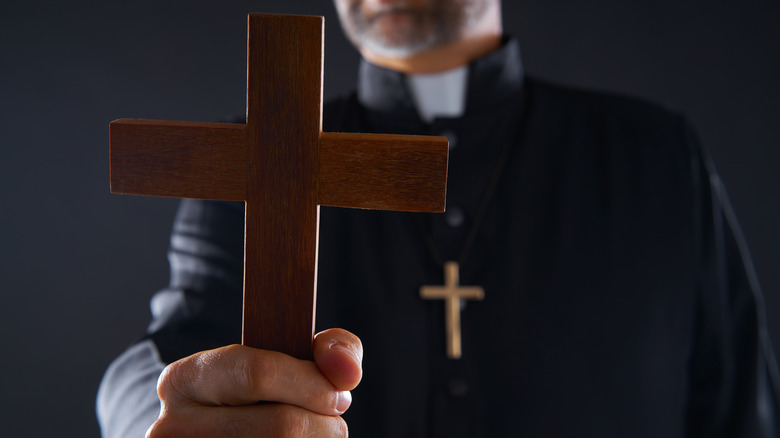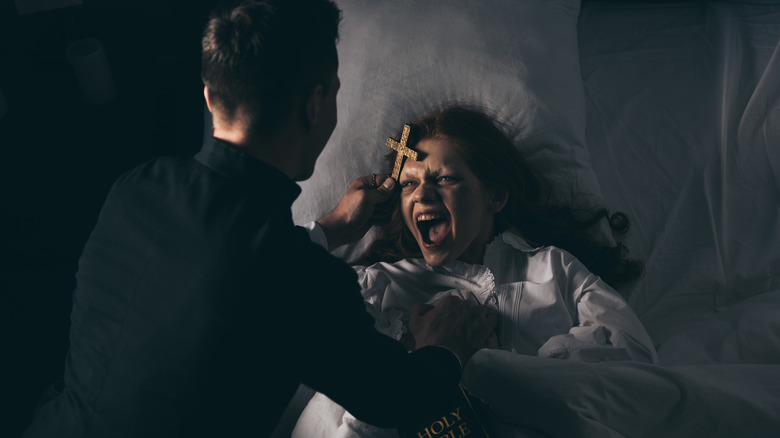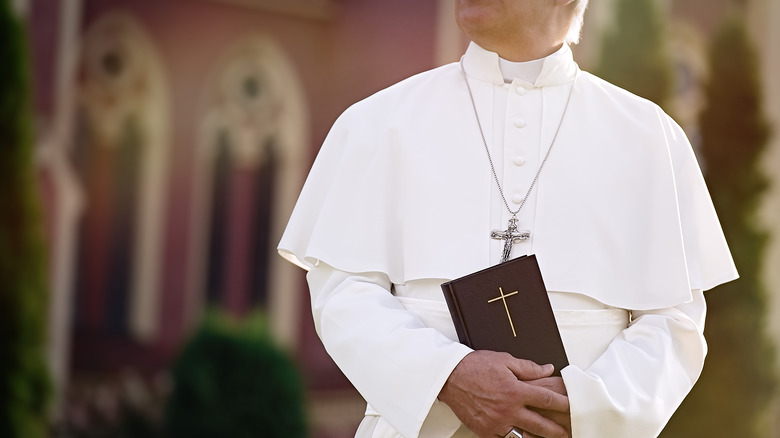The Dark Truth Behind The Vatican's School For Exorcisms
The word exorcism comes from the Latin "Exorcizo te," which translates to "I command you," a common phrase used during an exorcism to cast out demons. The Catholic Church has been practicing exorcisms for over 2,000 years, based primarily on the belief that Jesus Christ himself performed exorcisms and priests are simply continuing this rite. In Catholic belief, there are two kinds of exorcism. At its heart, an exorcism asks for protection against the Evil One; an exorcism prayer is part of the Rite of Baptism. In Catholicism, a major (or "solemn") exorcism, on the other hand — as depicted in popular culture — can only be performed by a priest with the permission of his bishop (per America Magazine).
Exorcisms might seem the stuff of horror movies, but every Catholic diocese actually has an appointed exorcist, although their identity is supposed to be a heavily guarded secret. And while you might think exorcists don't get a lot of work, according to research published on The Atlantic, about 70% of Americans believe the devil is real, while 50% think demonic possession doesn't only happen in movies.
In fact, the numbers are pretty impressive. According to BBC, over half a million people per year request an exorcism in Italy. The numbers are rising in the U.S., too. For example, the Archdiocese of Indianapolis received 1,700 requests for exorcisms in 2018, according to The Atlantic.
So how exactly do you request an exorcism? In modern times, it might be as simple as visiting your local Catholic diocese's website.
There's an actual book of rituals for exorcists
For example, the Archdiocese of Washington has a webpage explaining the steps for requesting an exorcism, which includes contacting your local priest, who will then decide if you should be referred to "the exorcism team of the Archdiocese" for a closer screening process.
In 1999, the Vatican published "De Exorcismis et supplicationibus quibusdam," a brand-new and updated, 90-pages-long exorcism manual. Up until then, exorcists had been using the same guidelines since 1614.
The manual doesn't actually change how an exorcism is performed, but it sets some basic rules. As quoted by The Guardian, the book outlines the signs of demonic possession, which haven't changed for 2,000 years and include super strength, speaking in tongues or languages the person doesn't actually know, and having knowledge of secret things and information about things or other people. But there's something new in the guidebook as well: a warning that these could also be signs of mental illness, and priests should be diligent in ruling out that possibility. If necessary, they should even "consult with experts in medical and psychiatric science who have a sense of spiritual reality."
What exactly happens in an exorcism? You can actually get a closer look at the Rite of Exorcism online via Catholic.org, but basically, there's a lot of praying, holy water, and Bible reading involved.
The Vatican has a very busy school for exorcists
Some exorcisms are easier and might take just one or two sessions, while others can be much harder. In fact, in 1982, Pope St. John Paul II himself, declared a saint in 2014, performed an exorcism that required several sessions before the woman finally went back to normal (per The Guardian).
There are no official statistics showing the number of "certified" exorcists in the U.S. or around the world, although the general estimate is that there are at least 100 in the U.S. alone. And while the church has often trained exorcists in different places, including Chicago, Rome, and Manila, there's only one formal school for exorcists, and it is inside the Vatican (via The Atlantic). According to the BBC, 250 priests from over 50 countries attended the Vatican's annual exorcism course in 2018.
While the course tackles the actual rite of exorcism, the Christian Post explains it also covers many other topics, including psychology and sociology, medicine, and law. Although originally meant only for Roman Catholic priests, the "Course on Exorcism and Prayer of Liberation" has been opened to members of the clergy from Anglican, Lutheran, Greek Orthodox, and Pentecostal Churches as well since 2019. The course lasts one week and costs around $400. For those who aren't Catholic, the course is still an important part of "the fight against Satan" — the main reason why spiritual leaders from other Christian denominations are flocking to the Vatican to take part in it (via BBC).


